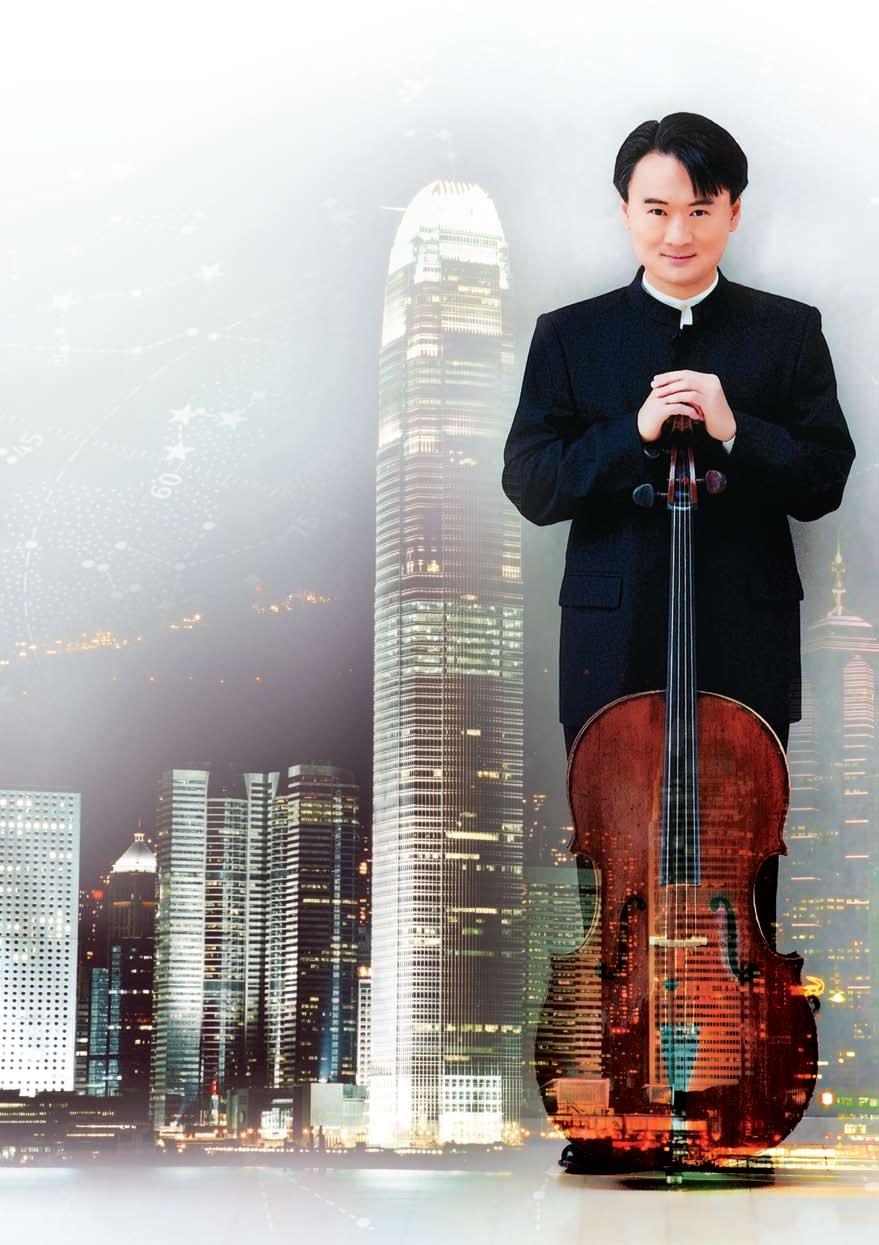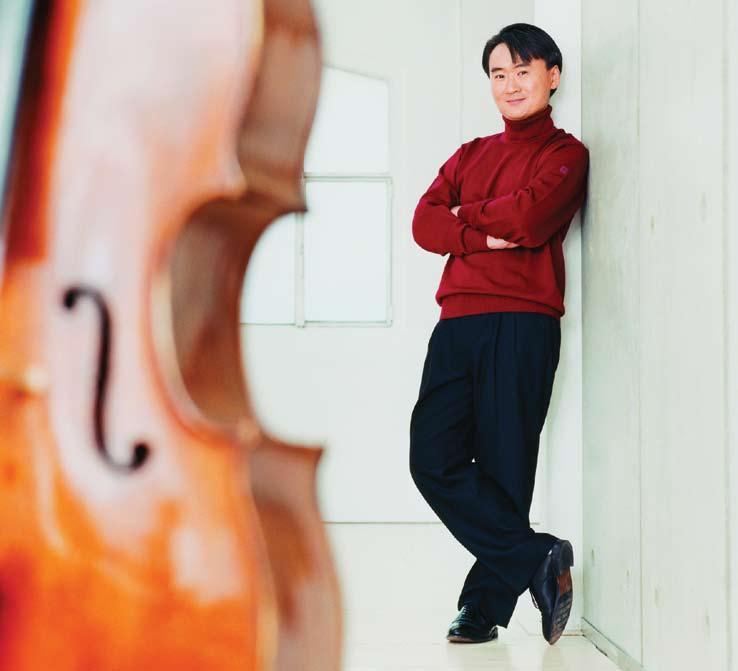


合作。他亦會巡迴澳洲演出,包括與 悉尼交響樂團及指揮家阿殊堅納西 合作。
王健曾灌錄多張唱片,由DGG發行; 近期作品有《夢幻曲集》(大提琴與結 他二重奏)及巴赫大提琴組曲。其他 作品包括與薩爾茲堡莫扎特學院樂團 灌錄的巴羅克音樂專輯,與柏林愛樂 樂團、小提琴家沙涵和指揮阿巴度合 演布拉姆斯的小提琴及大提琴雙協奏 曲,與由湯沐海指揮的古本奇昂樂團 合作灌錄海頓協奏曲,與鄭明勳、沙 涵及美亞合奏梅湘的《末日四重奏》 及與皮耶斯和杜美合作灌錄布拉姆 斯、莫扎特及舒曼的室樂作品。王健 所用的大提琴是由已故的林壽榮先生 之家人慷慨借出。

undertake an extensive tour to Australia including concerts with the Sydney Symphony Orchestra and Vladimir Ashkenazy.
His many recordings with Deutsche Grammophon Gesellschaft include, most recently, Reverie (arrangements for cello and guitar) and the Bach Cello Suites. He has recorded a Baroque album with the Camerata Salzburg, the Brahms Double Concerto with the Berliner Philharmoniker, Claudio Abbado and Gil Shaham, the Haydn Concerti with the Gulbenkian Orchestra under Tang Muhai, Messiaen’s Quartet for the End of Time (with Myung-Whun Chung, Gil Shaham and Paul Meyer) and chamber music by Brahms, Mozart and Schumann with Maria-Joao Pires and Augustin Dumay. His instrument is graciously loaned to him by the family of the late Mr Lam Sau-wing.
巴赫組曲
The Bach Suites

文:哈里.羅爾尼克 沒有人知道巴赫為什麼會創作組曲、
為誰而寫,甚至為哪種樂器而創作。
然而,這六首無伴奏大提琴(也可能 是18世紀的古大提琴或高音大提琴) 的組曲,卻被形容為至今最純淨、最 美妙的音樂作品。
巴赫為何創作出這六個組曲?1717 年,巴赫離開了魏瑪公爵宮廷後,便 前往科登宮廷當樂長,當時在任的王 子是卓越的音樂家,因而鼓勵巴赫創 作更多世俗音樂,在那裏度過了其音 樂成果最豐碩的六年光景。當時宮廷 樂團有兩位兼擅古大提琴的出色大提 琴手,據猜測,巴赫有可能為其中一 人或者兩位編寫這些組曲。大提琴並 非巴赫所長,因此他邊學邊寫,不單 耗盡了大提琴的聲區,更試用了至今 仍難於處理的大提琴和弦。
由於此作品乃私人創作,原稿至巴赫 死後20年才被發現。那時,沒有人認 為是公演作品,大提琴手大多僅用之 練習。在19世紀期間,很多編曲及作 曲家(如舒曼)均把組曲改編為大提 琴和鋼琴合奏。
西班牙大提琴家卡薩爾斯於巴塞隆拿 一家音樂店找到這些組曲,經過12年 苦練後,才敢於公開演奏。這組曲也 因而大受歡迎,直至今天。
Text: Harry Rolnick
Nobody knows why they were written, for whom they were written, nor even for which instrument they were intended. Yet these six Suites for unaccompanied cello (or possibly the 18th-century viola da gamba, or cello piccolo) have been described as amongst the purest and most sublime music ever composed.
Why did Johann Sebastian Bach write these six? In 1717, he left the formal court of Weimar and spent six of his most productive years at the Court of Köthen, where the reigning Prince was a fine musician, and where Bach was encouraged to write more secular music. The Court Orchestra had two excellent cellists, who also played viola da gamba, so it is surmised that Bach wrote these suites for one or both of them. The cello was not an instrument which Bach played, so he learned as he composed, exploiting the registers of the instrument and experimenting with cello chords which even today are difficult to play.
The work was so personal that the original manuscripts were not found until 20 years after Bach’s death. And when they were discovered, they were not imagined to be concert pieces. Most cellists who saw the Suites used them merely for practice. Over the 19th century, many editors and composers (such as Robert Schumann) arranged the Suites for cello and piano.
They began to achieve the popularity they have today because Spanish cellist Pablo Casals, who, after finding the Suites in a Barcelona music-store and practicing them every day for 12 years, finally dared to play them in a concert.
巴赫
D小調第二組曲,BWV 1008
前奏曲
阿勒曼德舞曲
庫朗特舞曲
薩拉班德舞曲
小步舞曲1及2
吉格舞曲

此前奏曲之複雜細膩或令人感覺它像
數學多於音樂。這當然只是說說罷 了。巴赫有無窮無盡的意念,因此他 決定將主意一併使出,達致激烈、具 張力、富即興效果的主題。尾段的小 節(除最後的一個外)則像一段長的 琶音。
阿勒曼德舞曲較為嚴謹,甚至有點拘 束。這是因為演奏家必須處理很多 雙音,尤其在樂章上半部。大提琴手 把D小調稱為「嚴謹」的調子,倒也 沒錯。
庫朗特舞曲充分表現巴赫豐富的想像 力。分解樂句中有一連串的連弓和單 一的十六分音符,編排完全不同,任 由大提琴手隨意發揮。一些陳腔濫調 的說法指巴赫在樂譜只寫上很少彈 奏指引,演奏者因而有很大的發揮空 間,這確實無疑。另外,這也是因為 巴赫希望演奏者在他的非宗教作品 中,可表現出更多個人創意。
薩拉班德舞曲中和弦部份和線性旋律 交替,令舞曲產生一種特殊的張力。
這種張力並沒有因兩個小步舞曲而消 失。第一個小步舞曲不算雄壯,又難 用於舞蹈上,卻帶點對抗反叛之感。
中間的小步舞曲稍作緩和,接着,我 們又再次回到巴赫「懾人的」舞曲。
最後的吉格舞曲並不是一貫的開心, 反見稜角和情緖化,把它形容為傲慢 比漫不經心來得更貼切。
2009年3月4日(星期三)
4.3.2009 (Wednesday)
Johann Sebastian Bach
Suite No. 2. in D minor, BWV 1008
Prelude
Allemande
Courante
Sarabande
Minuets 1 and 2
Gigue
The Prelude here is so intricate that some might call it more mathematical than musical. That is nonsense, of course. Bach has such a fecundity of ideas that he decided to put them all down at once, leading to agitation, tension and a wealth of improvisatory themes. The final measures (with the exception of the last) are like a long arpeggio.
The allemande is quite severe, even hemmed in. But this is because the cellist must tackle many double-stops, especially in the first half. Cellists say that the key of D minor is the “severe” key, so this makes sense.
The courante shows Bach’s great imagination. The broken phrases have a succession of slurs and single sixteenth-notes all placed in different ways, leaving it to the cellist to decide how to play. The cliché is that because Bach put few directions in this score, the player has a lot of leeway. That is true. But it is also true that Bach wanted his players, in his non-religious pieces, to show more personal creations.
The sarabande shows an alternation between the chordal parts and the linear melodic parts, giving a special tension to the dance. Nor does this tension stop with the pair of minuets. The first one is hardly gallant or danceable, actually sounding a little defiant. The middle minuet lets up for a little, but then we go back to Bach’s “in your face” dance.
The gigue is not your happy gigue either, but is angular, emotional and more arrogant than frivolous.

D大調第六組曲,BWV 1012
前奏曲
阿勒曼德舞曲
庫朗特舞曲
薩拉班德舞曲
嘉禾舞曲1及2
吉格舞曲

偉大的已故大提琴家羅斯卓波維奇稱 這組曲為「大提琴獨奏交響樂」,這 不僅是由於組曲所延展的變奏,更因 為D大調是「勝利與歡愉的曲調」。
其實,組曲也許並非為了大提琴而編 寫,而是寫給有五條而非四條弦線, 被喻為「高音大提琴」的細小版大提 琴。組曲原稿完全沒有指明演奏的樂 器,有人認為巴赫可能為了他所喜愛 的中提琴而創作。畢竟在18世紀時, 樂器這回事並非人人皆曉。
第一樂章是組曲是「交響樂」感覺的 例證。雖然樂章相對較長,且主要由 三連音組成,但每當樂章達致連串高 潮時,你即可感受到樂章的結構。樂 章沒有一刻緩和下來,從這裏你感受 到巴赫合唱作品的震撼。
阿勒曼德舞曲則沒有這樣的結構,但 它有大量音型變化、雙音和奇怪的和 聲變調。巴赫意識到他某程度上走得 太前,索性以簡單通順而活潑輕快的 手法寫下盡是跳躍的庫朗特舞曲,使 聽眾不會覺得有什麼問題。巴赫從沒 有到過意大利,但薩拉班德舞曲卻散 發一股意大利地中海風情:歡樂、豁 達和溫暖。
兩段嘉禾舞曲維持輕鬆的節拍,延續 了歡愉的氣氛。中間的嘉禾舞曲帶點 田園色彩,甚至可說是單純。最後的 吉格則可作管弦樂演奏,它是一首狩 獵歌曲,只要留心傾聽,你便會分辨 出狩獵號角聲、迴音和追逐的快感。
Suite No. 6 in D, BWV 1012
Prelude Allemande
Courante
Sarabande Gavottes 1 and 2
Gigue
The late great cellist Mstislav Rostropovich called this suite “a symphony for solo cello”, not only for its extended variations, but because the key of D major was “a tonality of triumph and joy”. In fact, the suite might not have been composed for cello at all, but for the so-called “piccolo cello”, a smaller version of the modern cello with five strings instead of the usual four. The original manuscript does not specify any instrument at all, and it is also thought that Bach, who loved the viola, might have composed it for that instrument. In the 18th century, little was certain about instrumentation.
The first movement is an example of this “symphonic” feeling. While relatively long, and consisting mainly of triplets, one can feel the architecture of the movement as it moves up to a series of climaxes. It never lets up for a moment, and one can feel as much the monumental here as in a Bach choral piece.
The allemande does not have this structure, but it does have massive amounts of figuration, double-stopping and very strange harmonic modulations. Bach realizes at a certain point that he has gone too far, and the courante simply skips, with no particular problems for the listener. It is easy-going and lightly vivacious. Bach had never been to Italy, but the sarabande has an Italian Mediterranean feel: cheerful, open and warm.
The two gavottes continue that cheerful mood, keeping up a lively tempo. The middle gavotte is rather pastoral, even childish. The final gigue could easily be orchestral. It is a hunting song, and listening carefully you can make out the hunting horns, the echoes and the joy of the chase.
巴赫
C小調第五組曲,BWV 1011
前奏曲
阿勒曼德舞曲
庫朗特舞曲
薩拉班德舞曲
嘉禾舞曲1及2
吉格舞曲

組曲的原來版本中,一條弦線被調低 了一個音,或許因為巴赫希望強調作 品更深層的素質。前奏曲包含了兩個 對比部份,所以它可說是「法國序 曲」的一種。首個部份緩慢而情感肅 穆,因而着重了低沉的音調。隨後是 較快而長的複音樂段,像賦格曲,但 只是一種假象或聽覺上的幻覺。考驗 大提琴手技巧的旋律線條一個接一 個,樂章最後非常震撼地結束。
阿勒曼德舞曲卻是一個強烈對比,它 莊嚴而慢、無雙音,且必須小心處理 才能有意義的彈奏出來。庫朗特舞曲 不只莊嚴:它實際上是嚴肅的,可見 巴赫並非僅為大師級樂手寫曲,而是 純粹有感而發。
這首薩拉班德舞曲是巴赫組曲獨一無 二、無可媲美的傑作。它包含一條
(無雙音)旋律線條,線條向外擴展 再收細,然後以巴赫特有風格再擴 張。你不必去嘗試了解這音樂結構, 盡情欣賞音樂大師為你「細說」的美 麗故事吧。
首段嘉禾舞曲改變節奏以保持張力, 這個改變伸延下去,貫穿了中間的舞 曲,使舞曲在三連音拍子當中特別 顯得強烈。就如吃過大餐後享受法式 甜品梳乎厘。吉格舞曲很是輕盈、 浮華,讓此偉大作品以優美的結尾 作結。
Johann Sebastian Bach
2009年3月5日(星期四)
5.3.2009 (Thursday)
Suite No. 5 in C minor, BWV 1011
Prelude
Allemande
Courante
Sarabande
Gavottes 1 and 2
Gigue
For the original version of this suite, one of the strings was tuned down one note, perhaps because Bach wished to emphasize the deeper quality of the work. The Prelude is actually the kind of overture called “French overture”, since it consists of two contrasting parts. The first is a slow serious emotional section which does emphasize the deep tones. After that comes a long polyphonic faster section. It seems to be a fugue, but that is a deception or an aural illusion. The lines follow each other with a very demanding part for the cellist, and it ends very powerfully.
The allemande is a great contrast. It is solemn, slow, uses no double-stopping and must be followed carefully for it to make sense. The courante is more than solemn: It is actually severe, and one can see Bach not writing simply for a master instrumentalist, but writing out of pure inspiration.
The sarabande is one of the unparalleled masterpieces of the Bach Suites — or anything else. It consists of one line (no double-stopping), but that line broadens out and contracts and then expands with the character that nobody but Bach could have produced. Don’t try to understand the structure — simply listen as a musical master “story-teller” tells a beautiful tale.
The first gavotte keeps the tension going by varying the rhythms, and this change continues throughout the middle dance, which, in its triplet meter shows a special vigour. Like a soufflé following a grand gourmet meal, the gigue is light, frothy and a pleasant ending to a monumental work.

C大調第三組曲,BWV 1009
前奏曲
阿勒曼德舞曲
庫朗特舞曲
薩拉班德舞曲
布雷舞曲1及2
吉格舞曲
C大調的使用讓人對這組曲更加了
解,它對於大提琴來說是最富豐、最 有共鳴回響的調子,而巴赫亦利用了 這廣闊調子的特質。你會在第一個樂 章聽得出,巴赫運用了簡單音階的首 半部份牽引至樂器的全部音域。第二 個部份則改變速度,他在這處建構了 整串廣闊的琶音,弓橫跨所有弦線, 加深及擴闊了樂章。當你以為尾聲已 到,巴赫又使出具「貝多芬風格」的 連串虛假結尾和華麗的裝飾樂句。
有人說阿勒曼德舞曲非常複雜,其實 這是魔術師巴赫以多不勝數的三十二 分音符和一些突如其來的雙音移形換 影,令最簡單的旋律線條看似複雜。
大提琴手神乎其技的演活了生動的庫 朗特舞曲。薩拉班德舞曲既不含蓄, 亦不賣弄玄虛,它散發着隆重、莊嚴 和高高在上的氣派。
我們不用對布雷舞曲多加解說,因為 它多次成為改編對象,是組曲中最耳 熟能詳的。布雷舞曲第二段孤小的獨 奏聽來像欠缺伴奏,所以當樂章返回 第一個親切曲調的時候,我們會感到 高興。結尾的吉格舞曲歡愉地跳躍, 讓大提琴手有機會表現靈巧的技藝。 事實上,你可以盡情享受大提琴能展 現的每個精妙之處。這樂章顯然是為 那些準備充足,並願意迎接巴赫佈下 的每一個挑戰的樂手而寫的。
Suite No. 3 in C, BWV 1009
Prelude Allemande
Courante
Sarabande
Bourrées 1 and 2
Gigue

樂曲介紹:哈里.羅爾尼克 中譯:易瑾
The key of C major tells a lot about this suite. For the cello, it is the richest and most resonant key, and Bach takes advantage of its openness. You can hear this in the first movement, where Bach offers a first half of simple scales taking off over the whole range of the instrument. The second section is a change of pace. Here he constructs an extensive set of arpeggios, the bow crossing over all the strings intensifying and broadening out the movement. And just when you think you have come to the end, Bach pulls “a Beethoven” with a series of false endings and grand flourishes.
Some say the allemande is very complicated, but this is Bach the magician, taking the simplest lines and making them seem complex through the use of endless 32nd-notes and some unexpected double-stopping. The lively courante is filled with dazzling virtuosity by the cellist. The sarabande is neither introverted nor mysterious. It is solemn, regal, and almost monarchial in its attitude.
No explanation is needed for the bourrées, since they are probably the most familiar movement in all the suites, transcribed in many arrangements. The lonely little solo second bourrée sounds like it needs companionship, so we are happy when we return to the more chummy first tune. The concluding gigue skips along amiably, with some spirited acrobatics for the cellist. In fact, you can hear just about every trick the cello can perform. It was obviously written for an artist who was ready for every challenge Bach offered.
Programme Notes by Harry Rolnick
